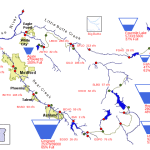CENTRAL POINT, Ore. — KDRV As firefighters, search and rescue teams, and utility crews continue to pick through the rubble of destroyed neighborhoods in Phoenix in Talent, some residents are asking why they did not receive notice to evacuate before the Almeda Fire was already on their doorsteps.
John Vial usually heads Jackson County’s Roads and Parks departments. At a press conference on Wednesday, Vial said that he’d been tapped as director of Jackson County Emergency Operations on Tuesday afternoon.



“This is a new role for me,” Vial said.
Vial described the County’s emergency notification system as one that may have been ill-equipped to handle the pace at which the Almeda Fire progressed, as it moved at “lightspeed” north from Ashland, and through multiple jurisdictions — but did not seem sure that there were better alternatives available.
Under Oregon law, only law enforcement officials have the authority to implement an evacuation, Vial said, but they depend on information from the field.
“In an event like [the Almeda Fire], the fire department’s called in, and they say we need an evacuation in this particular area,” Vial said. “Law enforcement reviews that area, and if a decision is made to support that action — which it almost always is — maps are produced, a narrative is written, and an alert is sent out.”
Jackson County uses Everbridge as its emergency alert vendor, a system that can send targeted alerts to people in specific areas via landline or cell phone. These alerts are supposed to go to anyone with a landline, and to cell phone users who specifically sign up to receive them — but only if the notifications are sent.
Sheriff Nathan Sickler said that he did not know if any emergency alerts went out to people in the Talent area that day, saying that it’s still something the County will have to examine at a later date.
According to Jackson County’s numbers, 43,472 phone numbers listed in the White and Yellow Pages are in the Everbridge system, in addition to 83,226 unpublished numbers or extensions for homes, businesses, and government offices. 54,246 people have opted in for alerts — and 41,911 sign-ups are new since last Wednesday.
Most people are still better acquainted with the venerable Emergency Alert System (EAS), which allows county, state, or national government agencies to broadcast alerts over radio and television.
Vial indicated that EAS was not used on the Almeda Fire because of several concerns, “speed and accuracy” among them. He likened the Everbridge and EAS tools to a “rifle or shotgun” approach, respectively.
On September 9, the day after the Almeda Fire’s rapid northward expansion, a second fire sprang up in Central Point. Central Point Police, through Facebook, ordered an immediate Level 3 “GO” evacuation of the entire city limits — an event that Vial obliquely referenced as an example of the EAS “shotgun” approach.
“At that point the entire transportation system stopped,” Vial said. “The freeway stopped, all surface streets stopped, everything stopped — nothing was moving. Fire personnel couldn’t get in to the site, and people couldn’t get out.”
Sheriff Sickler said that he was in the Phoenix and Talent areas on the day of the Almeda Fire as people fleeing the flames began piling up on roadways.
“The Everbridge system targets a smaller portion of the community, and had we sent out broad alerts that were more generic, but maybe a little more informative . . . if those roads had been blocked any more, and we can’t say what could have occurred, but it could have been tragic. We had a hard enough time clearing the roads to get people out as it was,” Sickler said.
Many of the people who rushed out of the area last Tuesday afternoon did so because they saw the encroaching smoke and flames, or heard from friends and family upwind of the fire. Others were ushered out by law enforcement going door-to-door or calling for the evacuations with loudspeakers.
“There are countless stories of officers and firefighters who risked their lives, going into burning areas to pull people out of their houses,” said Sickler. “And to me, that’s the best alert you can get is when someone is pulling you from a burning building, and saving your life. And that happened over and over again in this quick-unfolding fire that was moving at 30 to 50 miles an hour through our South County.”
Both Sickler and Vial said that law enforcement and fire officials generally have much more time to prepare evacuation warnings, orders, and alert notifications in a wildland fire event. But the choice of what system to use tends to be up to Jackson County Emergency Management or the County commissioners, Sickler indicated — once an evacuation request moves up the chain of command from firefighters, then to law enforcement, and finally to the County.
“The bottom line is, there are things to be learned from this process, things that the County’s going to have to review,” Vial said. “And when this emergency is over, when things have calmed down to a level that we can truly understand what happened, the County will be conducting a thorough debrief on these systems, evaluating the pros and the cons of each, and evaluating our performance and how we did . . . and changes will be made if necessary.”
As of Wednesday afternoon, Sheriff Sickler said that there were no “critical missing” individuals in the Almeda Fire area — meaning that no one listed as residing in the fire area is currently believed missing. Three sets of human remains have been discovered so far, a number that has not changed since Monday.





